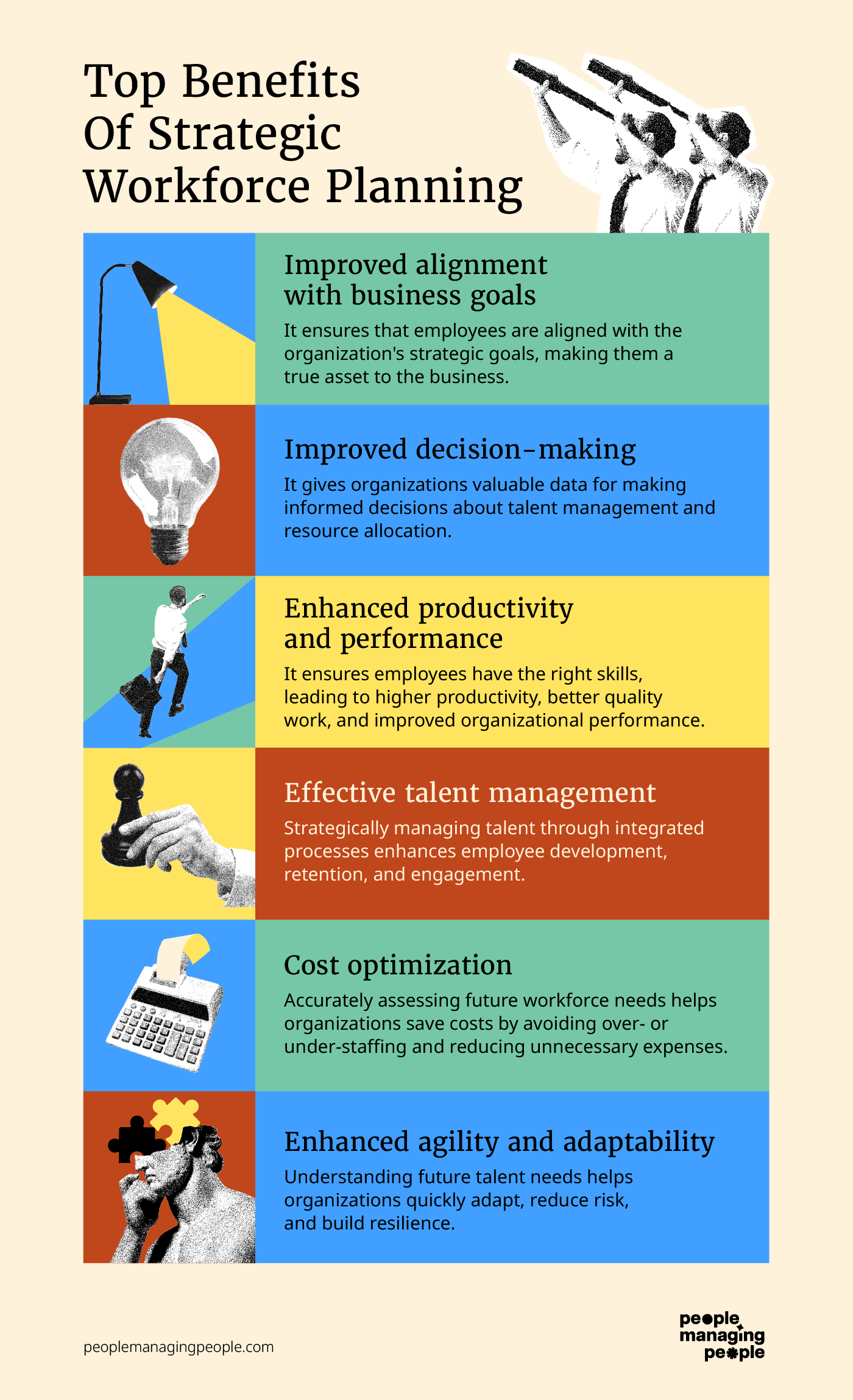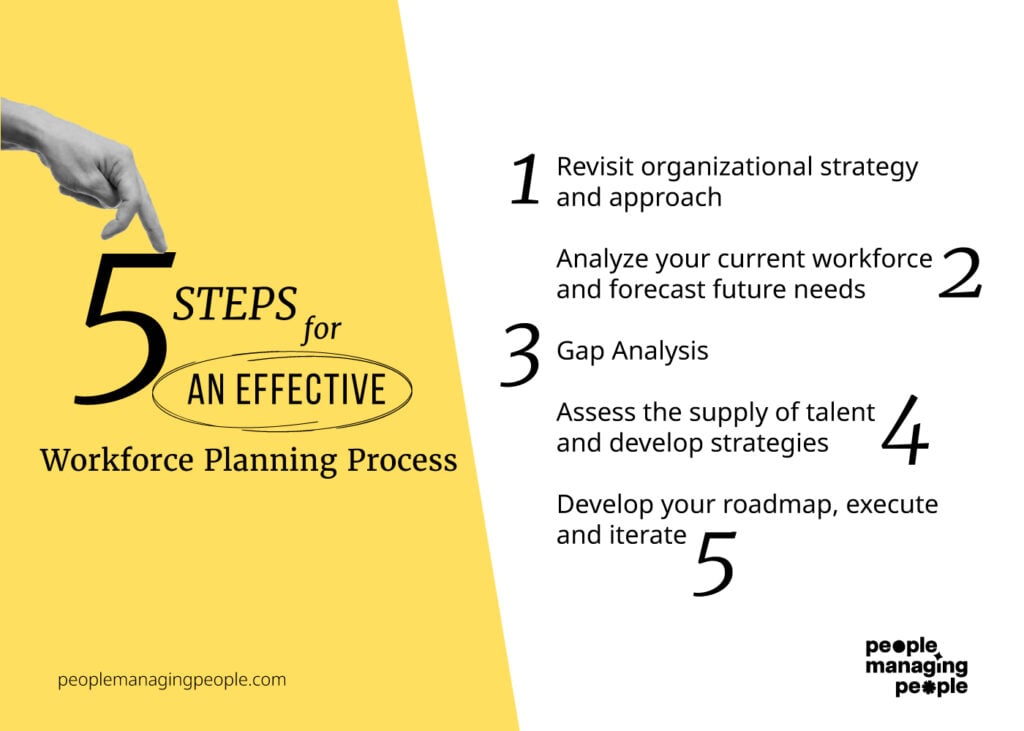Workforce planning is the process of analyzing your current workforce in terms of skills and capabilities and then developing strategies to have the right people in the right roles at the right time to realize your future objectives.
Workforce planning helps us to proactively manage our workforce, anticipate talent gaps, and make informed decisions about recruitment and talent development.
Effective workforce planning leads to improved operational efficiency, increased productivity, higher employee engagement, and a competitive advantage in the marketplace.
As an HR and business leader, workforce planning is a fundamental part of my role. Here I’ll share my process and best practices to help you get it right.
What Is Workforce Planning?
Workforce planning (WP) is a strategic process that organizations leverage to ensure their workforce is aligned with their goals and objectives. It involves analyzing the current workforce, forecasting future talent needs, analyzing the market, and creating strategies to ensure the necessary talent is in place to achieve strategic goals.
“Workforce planning is more than budgeting for, attracting, and hiring talent. It’s about supporting your entire workforce—building an intelligent feedback mechanism between your current and future business interests and the acquisition, retention, and development of the employees who will drive those interests.”
While you can think of this as a simple gap analysis type exercise, the successful execution of workforce planning is significantly more complex.
You need to have a comprehensive understanding of your business goals and objectives, your current talent capabilities, the future human capital needs of your organization, and the world you’re operating in.
The interplay between these elements becomes your strategic plan to meet future talent needs.
benefits of strategic workforce planning

Before we talk about how you can approach your workforce planning efforts, let’s first examine why it’s so important for you to keep workforce planning in your strategic arsenal of talent tools.
Improved alignment with business goals
The primary benefit, and ultimately the purpose of workforce planning, is to ensure that an organization's workforce is aligned with its strategic objectives.
While the old adage of “Our employees are our greatest asset” may sound cliché, it’s still fundamentally true.
However, even the most talented workforce won’t be an asset if it’s not strategically aligned with your business needs. A soccer team probably wouldn’t prioritize buying a defender if they'd failed to score a goal all season!
Improved decision-making
Workforce planning provides organizations with an enormous amount of rich data. This allows organizations to make data-driven decisions about talent acquisition, development, and deployment.
This enables leaders to allocate resources efficiently and align the workforce to the organization’s true strategic priorities.
Enhanced productivity and performance
Workforce planning helps ensure that employees are equipped with the appropriate skills needed to perform their jobs effectively, resulting in higher productivity, improved quality of work, and better overall organizational performance.
Effective talent management
Workforce planning enables organizations to strategically manage their talent pool.
Workforce planning, performance management, talent reviews, and succession planning should all work hand in hand to identify high-potential employees, develop succession plans, and develop the skills your employees need for the future.
This enables employee development, improves retention rates, and boosts employee engagement.
Cost optimization
An accurate assessment of future workforce requirements allows organizations to optimize their staffing levels and avoid over- or under-staffing. This leads to cost savings by reducing unnecessary recruitment, training, and termination expenses, and prevents productivity impacts due to labor shortages.
Enhanced agility and adaptability
A deep understanding of future talent needs enables organizations to quickly adapt their workforce strategies, train or hire talent with required skills, and address emerging challenges or opportunities proactively rather than reactively. This is essential for reducing/mitigating organizational risk and building resilience.
Workforce Planning Example
To provide a bit more color, let me give you an example of a time when workforce planning was essential to helping an organization I supported.
I once worked as an HR Business Partner in a large organization and had a call center within my remit. A change in leadership placed higher expectations on this call center.
The new leadership team expected higher service levels while also reducing wait times and call abandonment rates. They also expected a higher level of resiliency, including mitigating impact from severe weather events and flexibility based upon variable call volume.
Through our workforce planning process, we were able to come up with a strategy that fundamentally changed how the organization functioned.
Higher expectations came with a need to augment staff. However, the well of talent in the New England geography we functioned out of had mostly dried up.
So, rather than trying to only hire locally, we set up remote hiring hubs in the southeast and southwest of the US.
Not only did this enable us to tap into new markets for talent, it also made us more resilient by providing coverage when the famous nor’easters that descend on the New England area hit, or when other events impacted local business.
Further, the remote hiring hubs were in lower-cost-of-living areas with cheaper labor pools. This meant we could simultaneously increase our service levels without a significant increase in labor costs.
Without engaging in the workforce planning process, we likely would have continued our normal hiring strategy, spun our wheels, and struggled to meet the expectations of our leadership team.
5-step Workforce Planning Process

Step 1: Revisit organizational strategy and approach
Your organizational strategy is the Northstar of everything you do from a strategic human resources management perspective and strategic workforce planning is no exception to the rule.
If anything, the rule applies tenfold. Without a deep understanding of the direction of your organization, it's impossible to effectively conduct a workforce planning exercise.
My recommendation to you would be to revisit your multi-year strategic roadmap and ensure all participating leaders are aligned around the organizational imperatives you’re working towards.
If your strategy is unclear, pause on workforce planning and conduct a strategic planning exercise first.
Step 2: Analyze your current workforce and forecast future needs
I mentioned earlier that workforce planning enables data-driven decision-making. That means you will need sufficient insights into both your current workforce capabilities and future needs.
The data you collect will need to be customized based on the strategic business needs and direction of your business, but, ultimately, you’re looking for insights into the composition and capabilities of your current workforce.
Focus on skill gaps, areas where you are either over or understaffed, critical roles to your business, and other key risks.
Based on your organization's strategic goals and anticipated changes in the business environment, you can forecast the future demand for various types of employees, skills/capabilities, and the volume or talent you will need.
Questions to ask yourself include:
- Where do you anticipate growth or contraction in your org?
- How does this impact headcount/your number of employees?
- Are there changes in market conditions that impact the work you do and the talent you need?
- How do technological advancements (e.g. artificial intelligence) impact the work your colleagues do? Will they need new skills to interact with those advancements?
Based upon all these considerations, your leadership team can develop models to estimate the future demand for different job roles and skills.
Step 3: Gap analysis
This step is as straightforward as it sounds: you conduct a skills gap analysis by comparing your future needs versus the current capabilities of your workforce.
Essentially, you compare the forecasted demand with the projected supply to identify any gaps in skills, competencies, or workforce size.
This gives you key information associated with where you’ll need to spend the time, energy, and money to be successful in the future.
This is also an opportunity to identify potential risks or constraints and pinpoint areas requiring attention during the decision-making process.
Step 4: Assess the supply of talent and develop strategies
In planning for your future talent needs, you need to look at the availability of talent both internally and externally.
Your current employee population will have a unique set of knowledge, skills, and abilities that you may need to augment by either upskilling your current workforce or supplementing with additional labor.
This could involve recruitment, training and development programs, succession planning, workforce restructuring, or outsourcing.
It’s important to understand external labor pools for the talent needs required for you to be successful. Some questions to ask yourself here:
- Do you require niche or specialized talent that’s difficult to recruit?
- Are you able to hire sufficient talent with those skills in the geography your organization recruits from?
- Are there roles that would be a better fit for an independent contractor vs an employee?
- Are there seasonal labor shifts that might impact your ability to hire talent?
- Does the market put a premium on compensation for the work your organization does?
These insights will help you plan effectively to meet your talent needs. You may need to plan for additional compensation, expand your hiring geography to source from additional sources (e.g. hiring work-from-home talent, candidates on work-based immigration visas, or contractors), or use more advanced talent sourcing software to cast a wider net with your job postings.
Step 5: Develop your roadmap, execute and iterate
Once your strategies are determined, it’s time to develop a strategic roadmap to close your skill gaps. This could be learning and development-based, org design-based, succession planning-based, recruitment-focused, or a combination of all of the above.
Once you implement the strategies you’ve devised, continuously monitor and evaluate their effectiveness. This may involve tracking KPIs and other key metrics, adjusting strategies as needed, and ensuring that the workforce remains aligned with changing business requirements.
Additionally, it’s important to evaluate the effectiveness of your workforce planning process. What went well? What would you change for next time?
It’s helpful to have a retrospective conversation with all parties involved to learn from your experience and ensure the next iteration will be even more successful.
These insights will help you plan effectively to meet your talent needs. You may need to plan for additional compensation or expand your hiring geography to source from additional sources (e.g. hiring work-from-home talent or potentially hiring candidates on work-based immigration visas).
Tools and resources to support workforce planning
There are numerous workforce planning courses you can take as well as tools that can support you on your workforce planning journey. The tools you’ll need will vary drastically based on your organization’s size, complexity, and business plan.
Workforce planning software
Depending on your needs, dedicated workforce planning software could be the best solution to support your needs.
These types of applications can help you with your workforce planning needs by giving you visibility to your entire workforce, generating reports, data and analytics tools, and even modeling ‘what if’ type scenarios to test the impact of your workforce-related decisions.
HR analytics/business intelligence (BI) software
Comprehensive HR analytics is essential to proper workforce planning. Through your HRIS and other inputs, you’ll likely have access to very rich employee/workforce-related data.
But, without the ability to slice and dice that data per your specification, you’ll never be able to glean the necessary insights to make proper workforce planning decisions.
Luckily there are many BI tools out there that you can leverage for data visualization and analysis, including Tableau and Power BI.
Talent marketplace
Talent marketplace software can also give you rich access to employee competency and skill data.
While the true purpose of a talent marketplace is a colleague development solution that matches employees to opportunities based on their competencies, skills, and values, the competency/skill data collected through these tools can be immensely helpful in the workforce planning process.
It will give you visibility into the skills your workforce has today and where they want to grow/develop, allowing you to assess the future skills needs of your organization.
This empowers your organization to make educated decisions about where to invest from a learning and development perspective, which skills to hire for, and can simultaneously help with employee engagement and retention.
Key organizational information
In addition to any formal tools that you’ll leverage for workforce planning, there’s also other key organizational information you’ll want at your fingertips during the process.
- Business strategy documentation. Workforce planning is tied back to enabling your organization’s strategy as it’s Northstar, so you must have a deep understanding of your business strategy and your strategy documentation handy for reference along the way.
- Talent review and succession planning. The talent review and succession planning processes are kindred spirits to workforce planning and provide you key insights into what you have today, the capabilities you need tomorrow, and your approach to developing key talent to fill any gaps (especially critical roles identified through succession planning). This is a vital input into the talent side of your workforce planning process and is tremendously aided by tools and the format you chose, be it a 9 box talent review or some other approach.
- Compensation and finances. Your employee compensation and financial data are also a key part of the workforce planning conversation. After all, if your workforce is going to expand or contract this could majorly impact your organization's financials.
Workforce Planning Best Practices
Data comes first
Data is an essential input into effective workforce planning and, without access to that data, your workforce planning efforts will be futile.
Harvard Business Review reports that “An inability to connect operational, people, and financial data to business outcomes impairs agility, according to 49% of leaders responding to a 2022 global survey by Workday. And only 12% of those leaders say their organization’s data is fully accessible to those who need it.”
Have a solid HR analytics strategy in place before you begin to attempt workforce planning. You’ll thank me later!
Get the right people in the room
Workforce planning is a collaborative effort that involves multiple stakeholders within an organization.
- Senior leadership. This is an activity that I believe should be business-owned and HR-facilitated, so it’s essential that your executive leadership team is involved in the process to provide strategic guidance and ensure the process complements your overall business strategy.
- HR team. Your HR team should be accountable for designing and facilitating the process, providing HR tool list support, and expertise on talent management, learning and development, and the development of other workforce strategies.
- Finance. Finance can assist in analyzing the cost implications of various forecasting scenarios, budgeting for your workforce strategies (recruitment, learning and development, organizational design, etc.), and evaluating the ROI of your WP efforts.
- Front-line managers. I believe it’s important to bring front-line managers into the process. After all, they’re closest to the work and will have an intimate knowledge of their teams’ capabilities, strengths/development areas, workload, staffing needs, and other operational requirements.
Need help? Phone a friend
Workforce planning is a highly in-depth process and requires a significant amount of time, effort, and energy to be poured into for you to get the results you’d be hoping for.
If you’re inexperienced with the workforce planning process, it might help you to hire a consulting firm to help you through the process.
An added benefit is that consulting organizations generally have access to a significant amount of global market trends, research, and analysis that can give you insights into the external labor market that you wouldn’t have access to otherwise.
You could also consider taking one of these workforce management certifications.
Change management
Don’t under-index on a quality change management plan. Your strategies could mean a significant amount of change for your organization and team members.
Remember: Data Is Key
It’s essential that your leaders act as change leaders and take your colleagues on the right journey to address their wants and needs along the way.
Workforce planning is an essential process for both organizations and their leaders/HR teams to develop. While it can be a daunting task, it doesn’t have to be.
This can and should be viewed as a normal part of your strategic planning process. After all, what kind of plan would it be if you didn’t have a people-based strategy in place to execute against it?
The best advice I can give you is not to underestimate the importance of high-quality data and analytics.
It takes meaningful data to draw meaningful insights, so, if you have to start somewhere, start with how you can pull together the right compilation of data that will inform how you achieve your business strategy.
Liam Reese’s HR metrics article is a great starting place for this.



